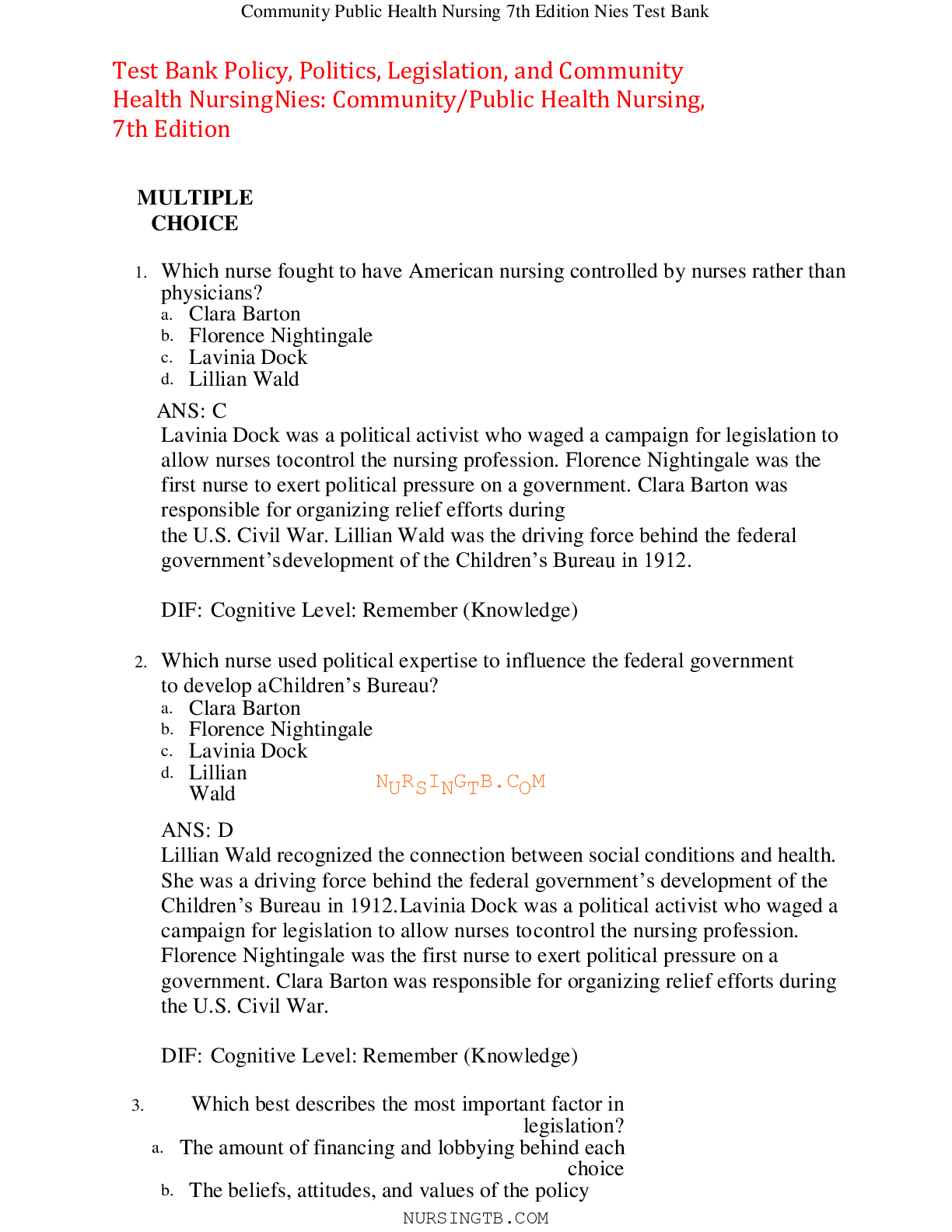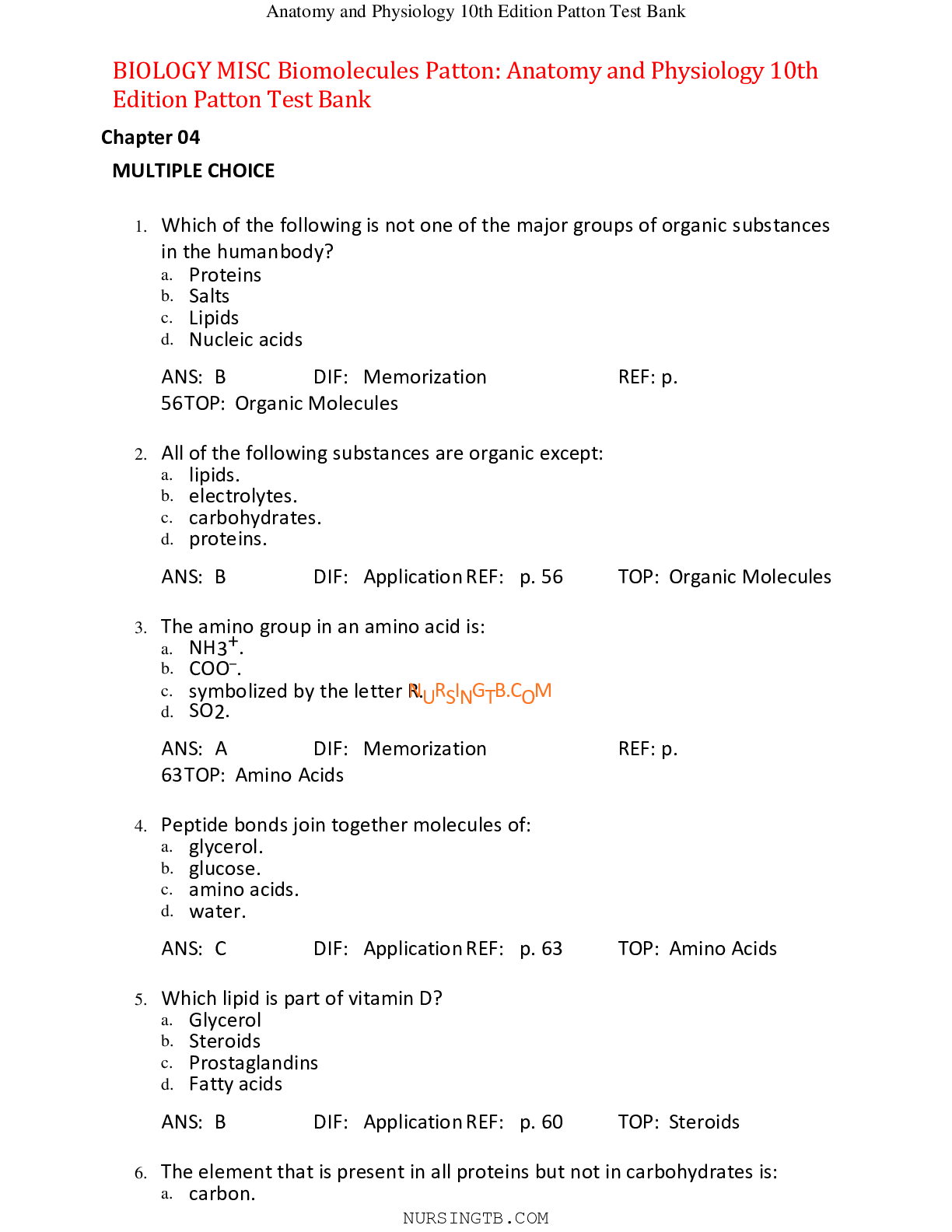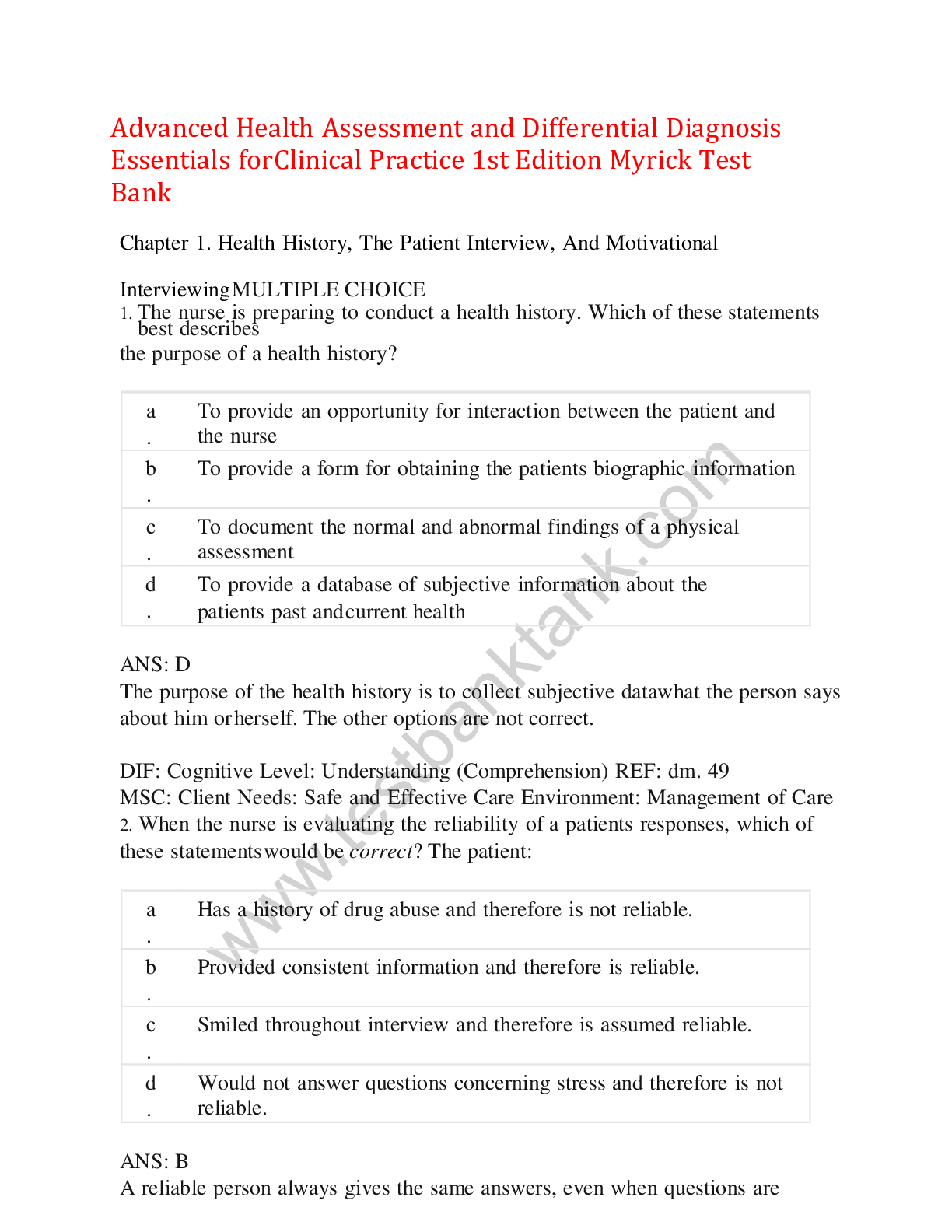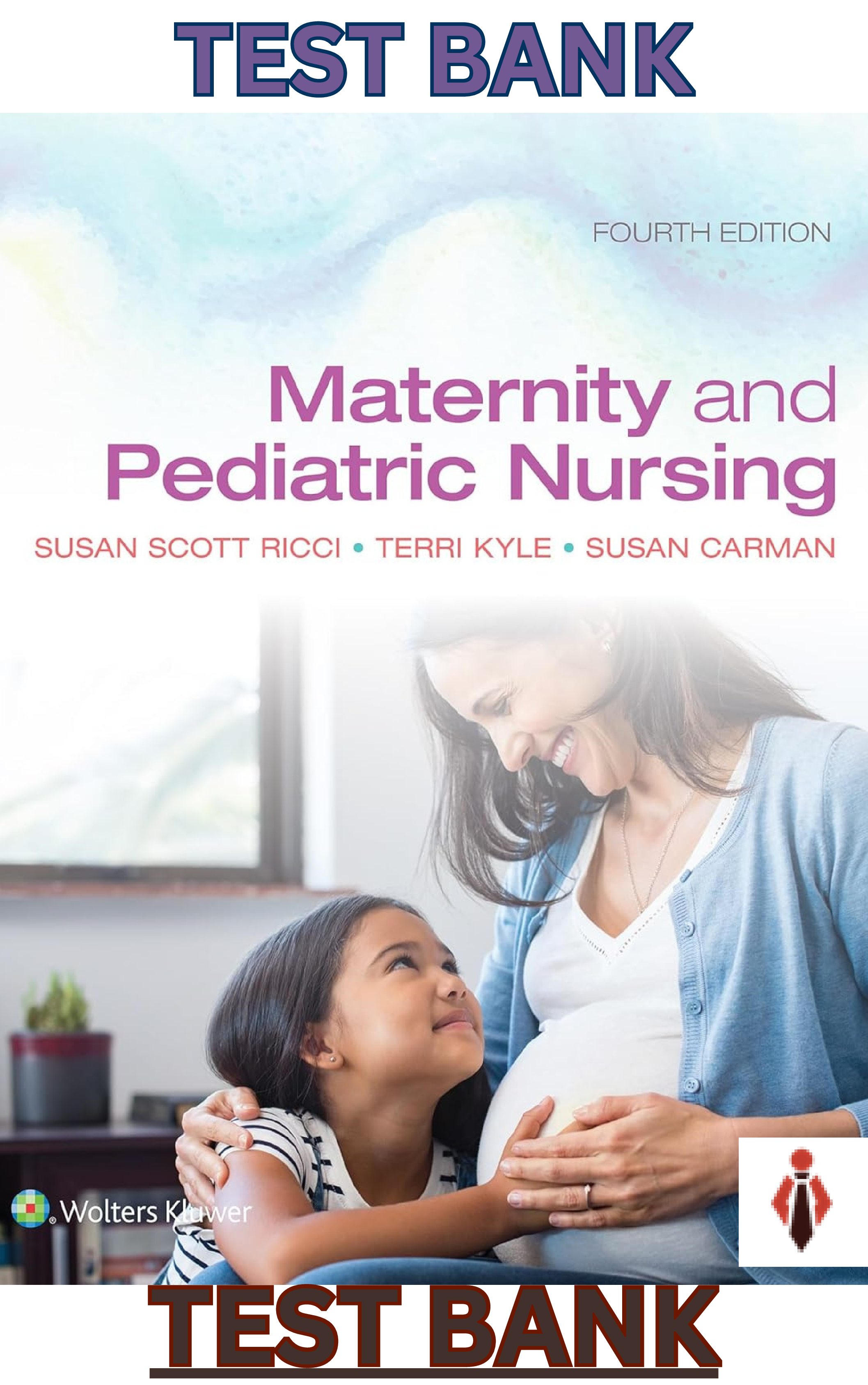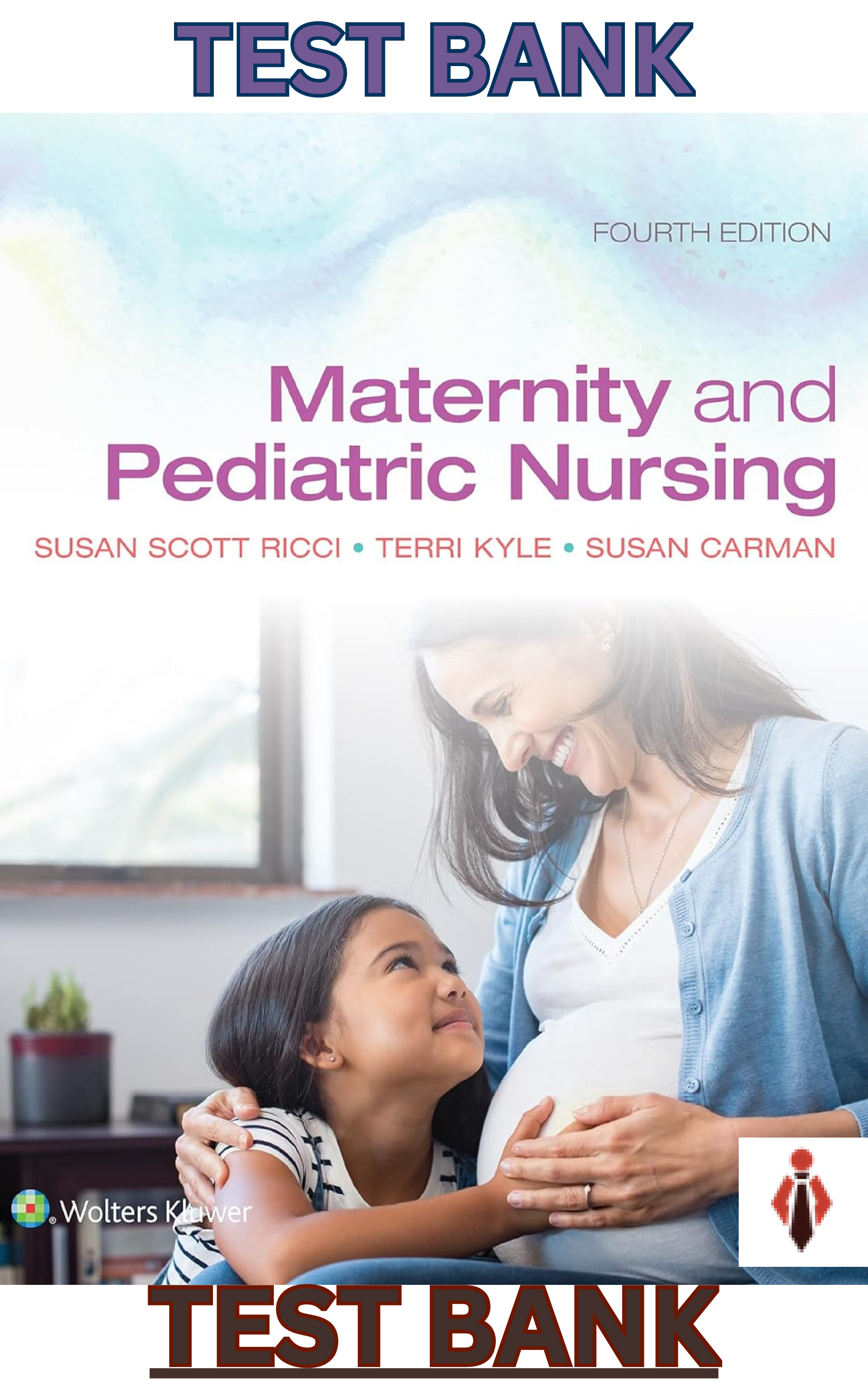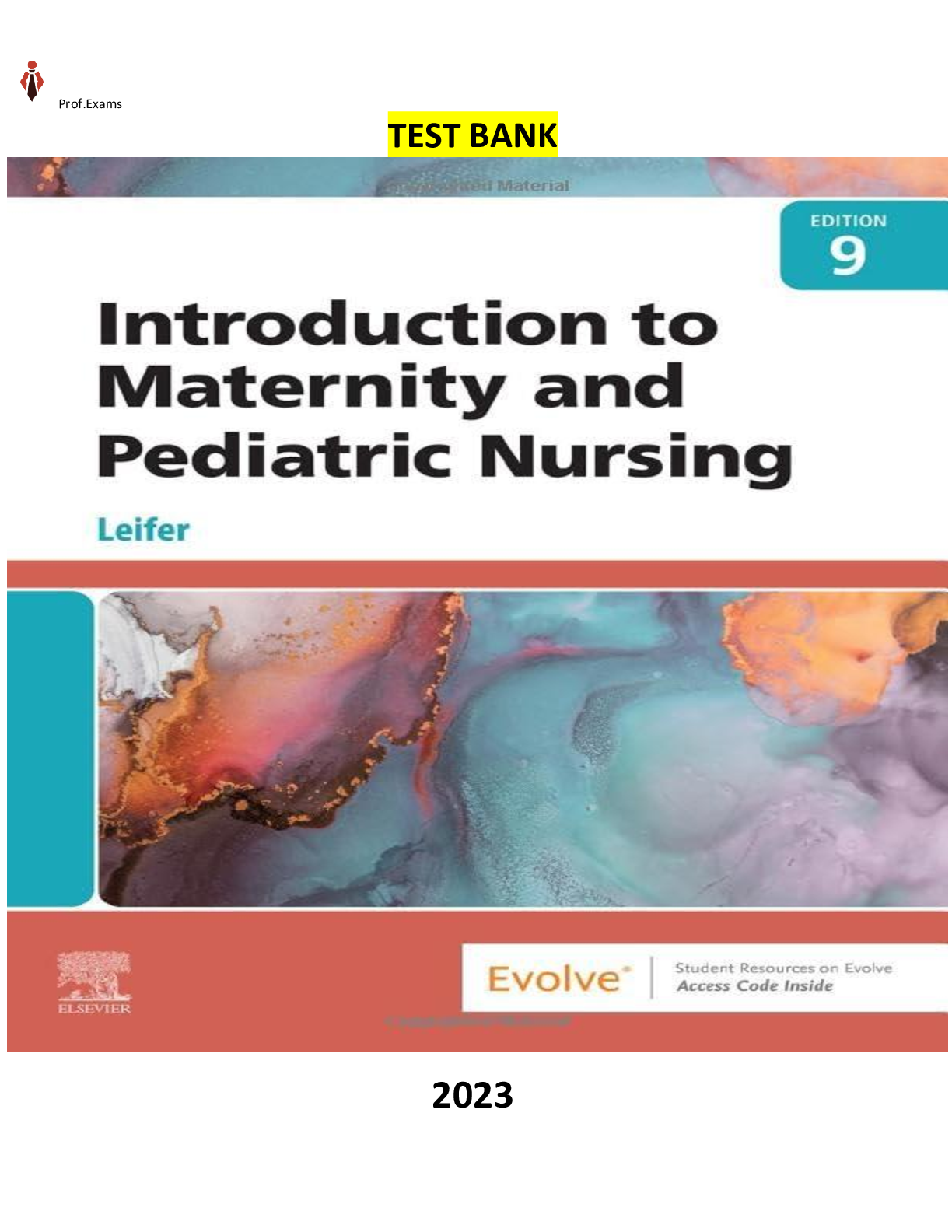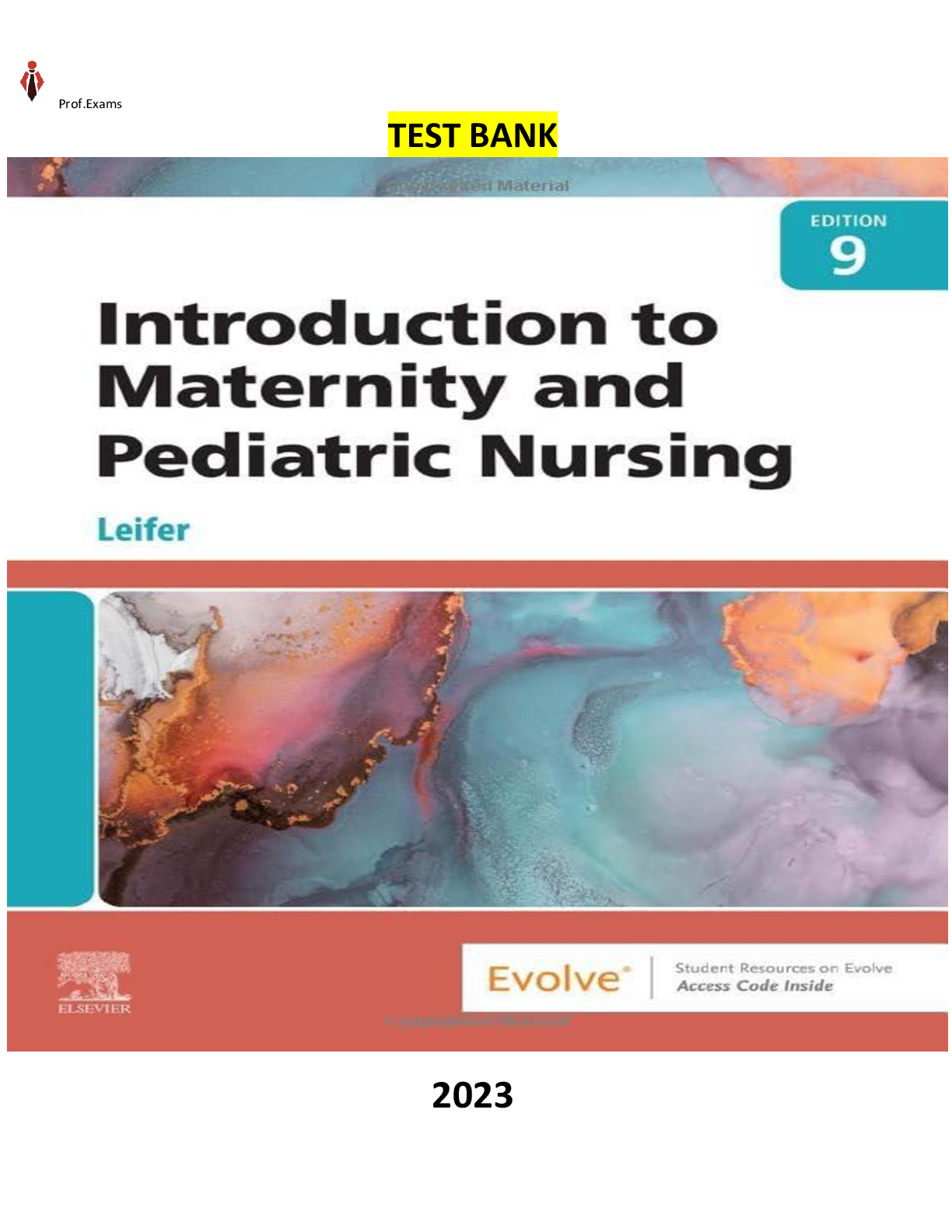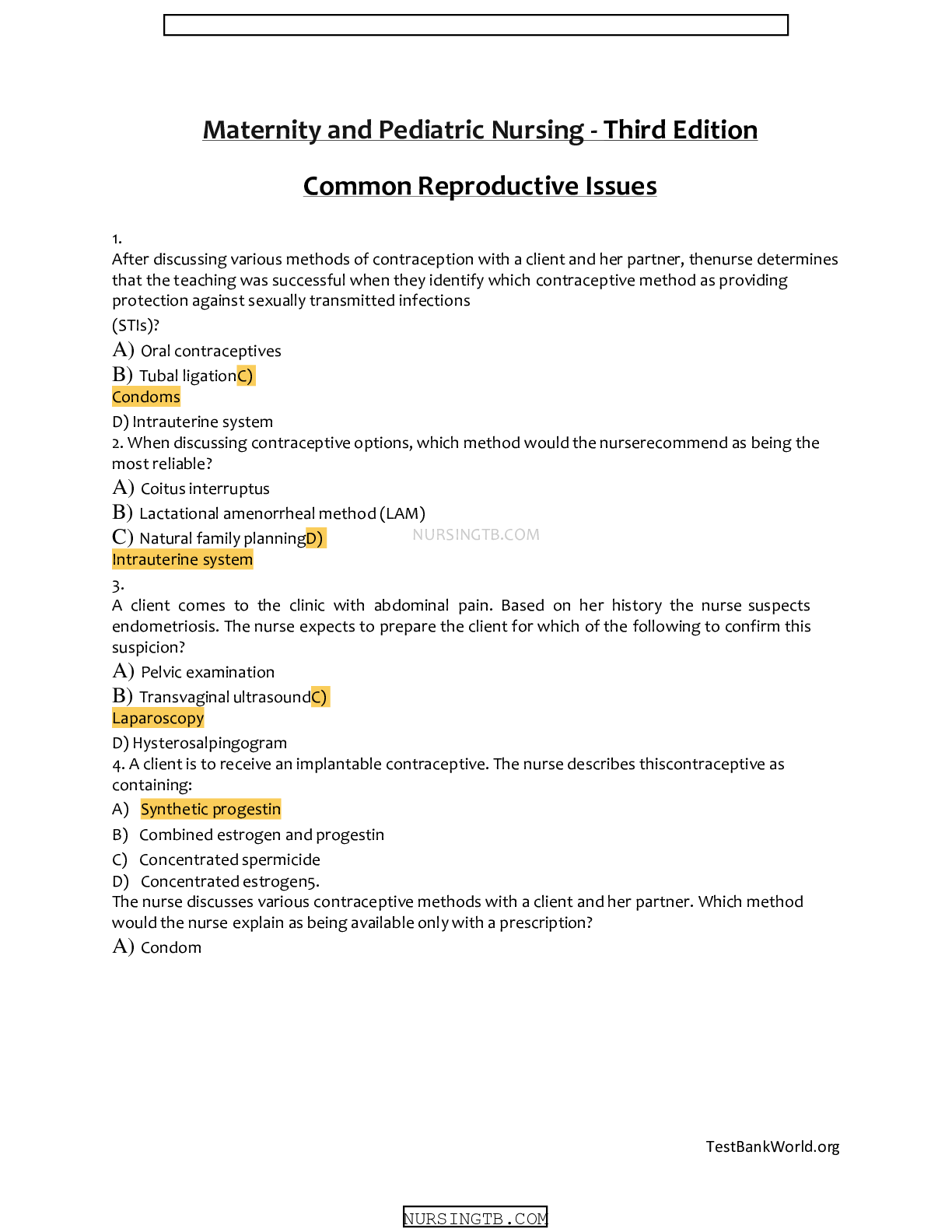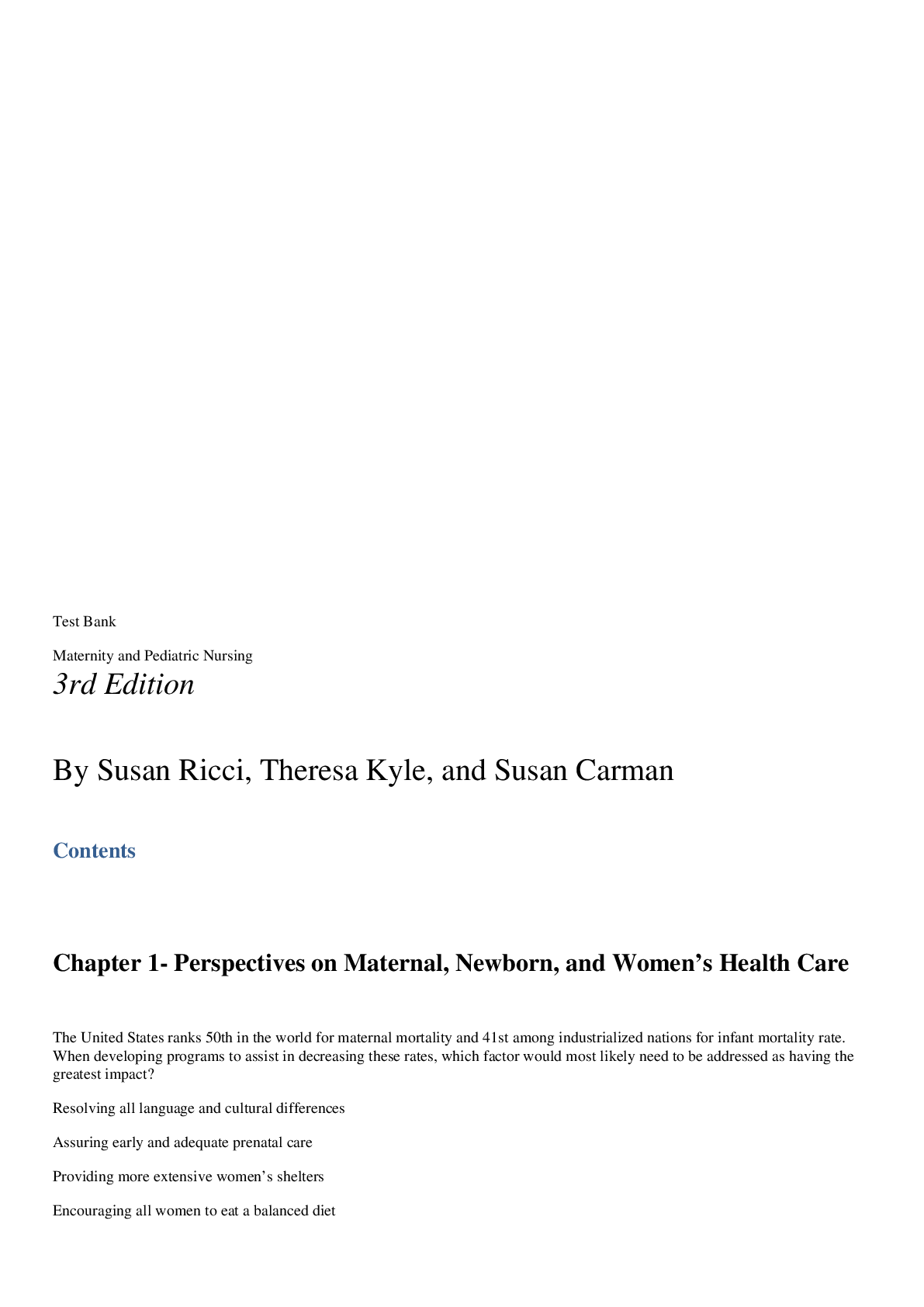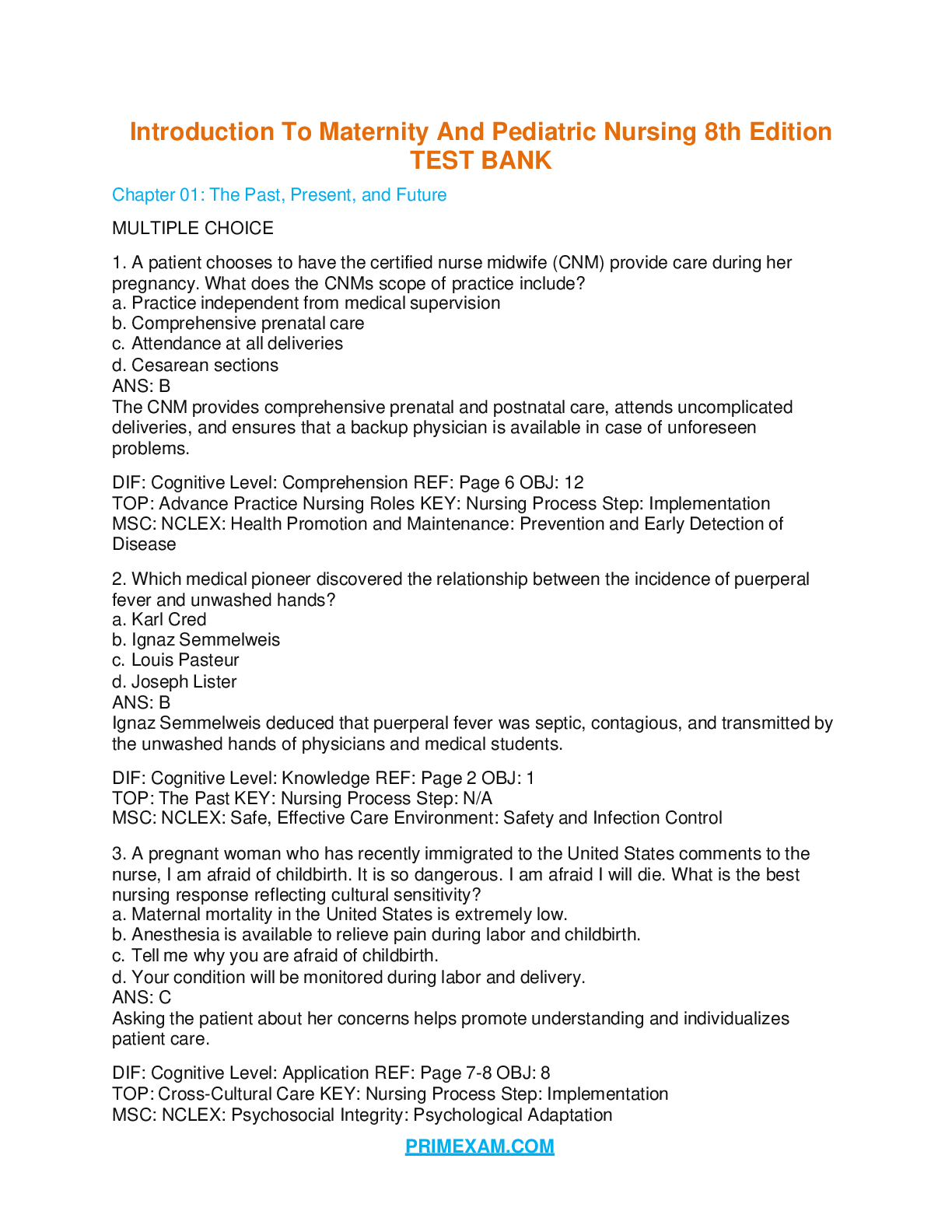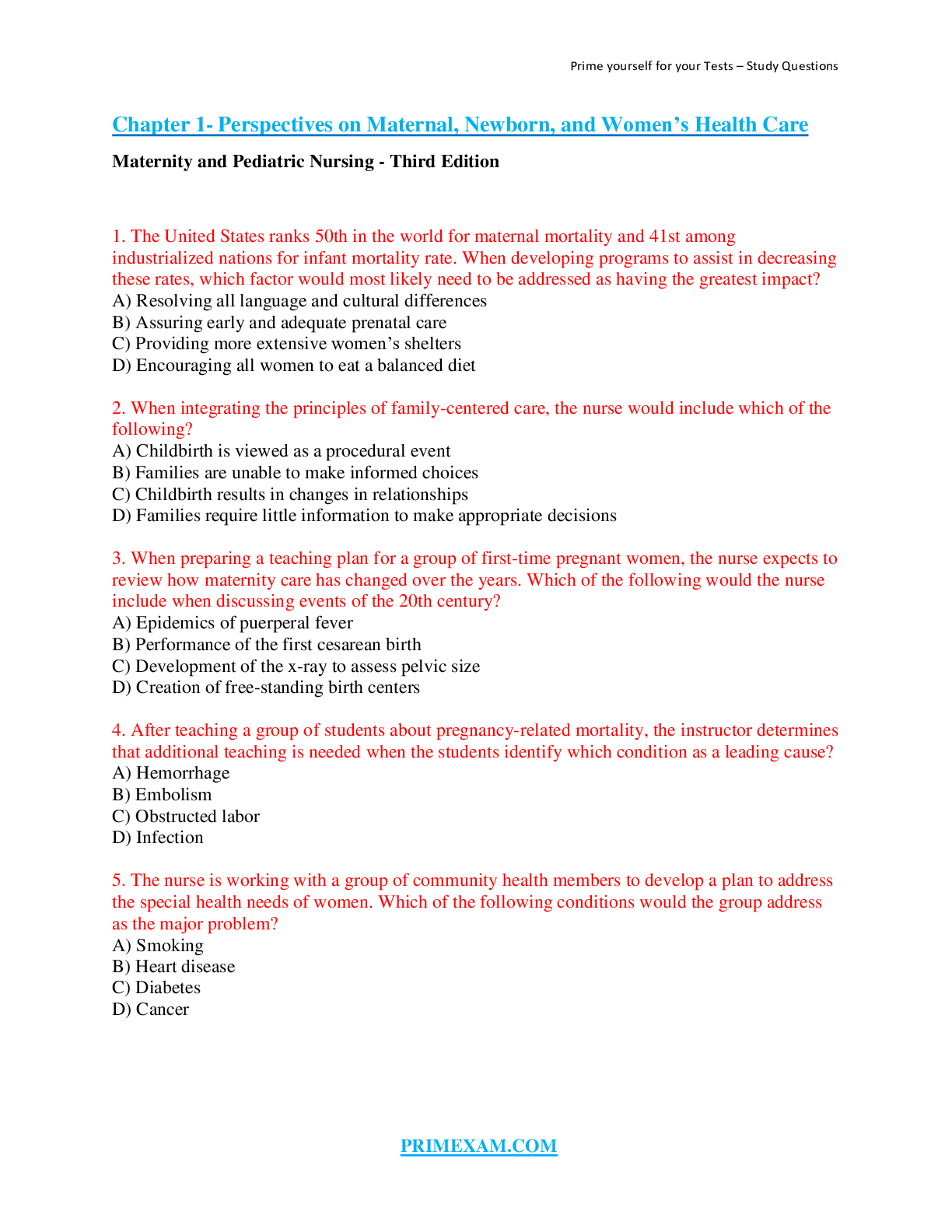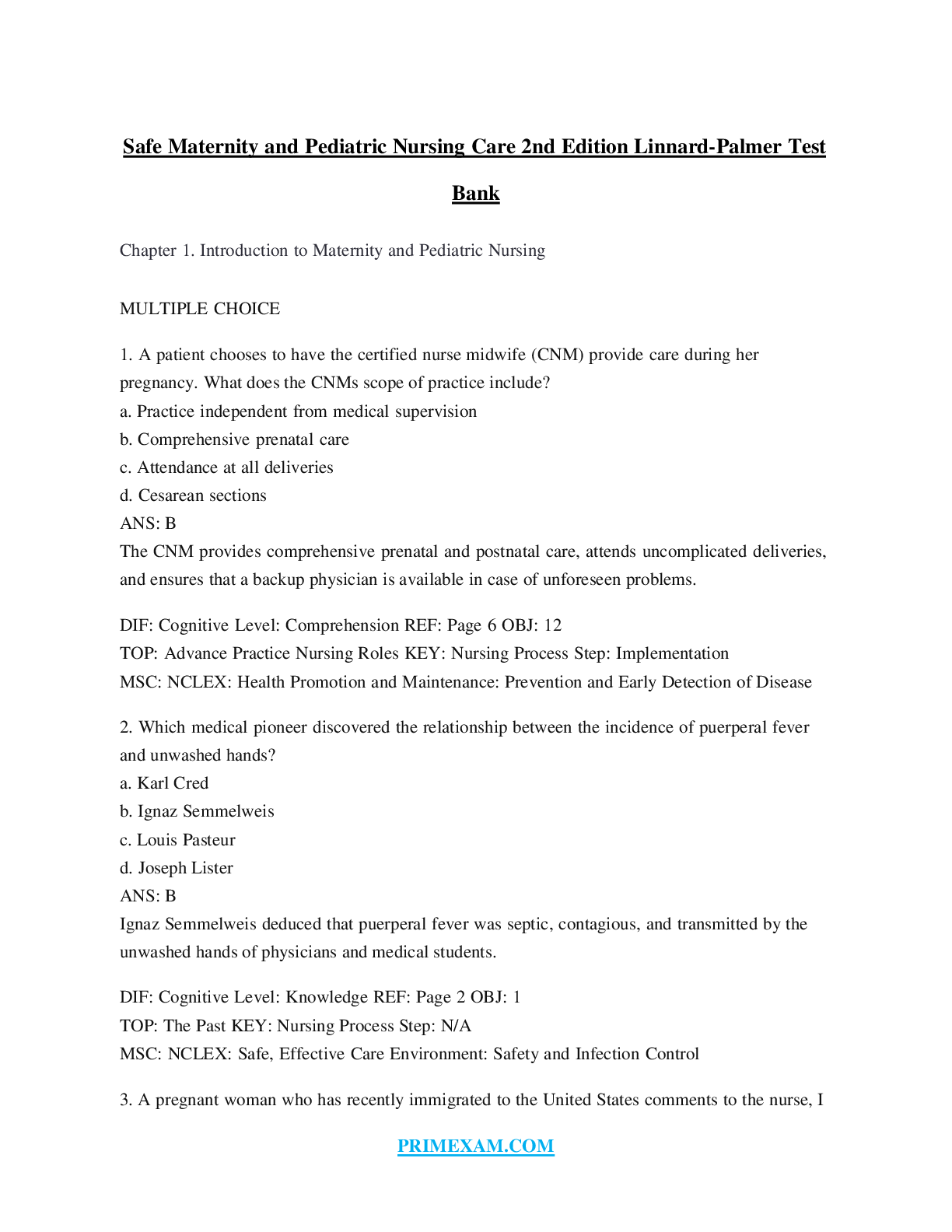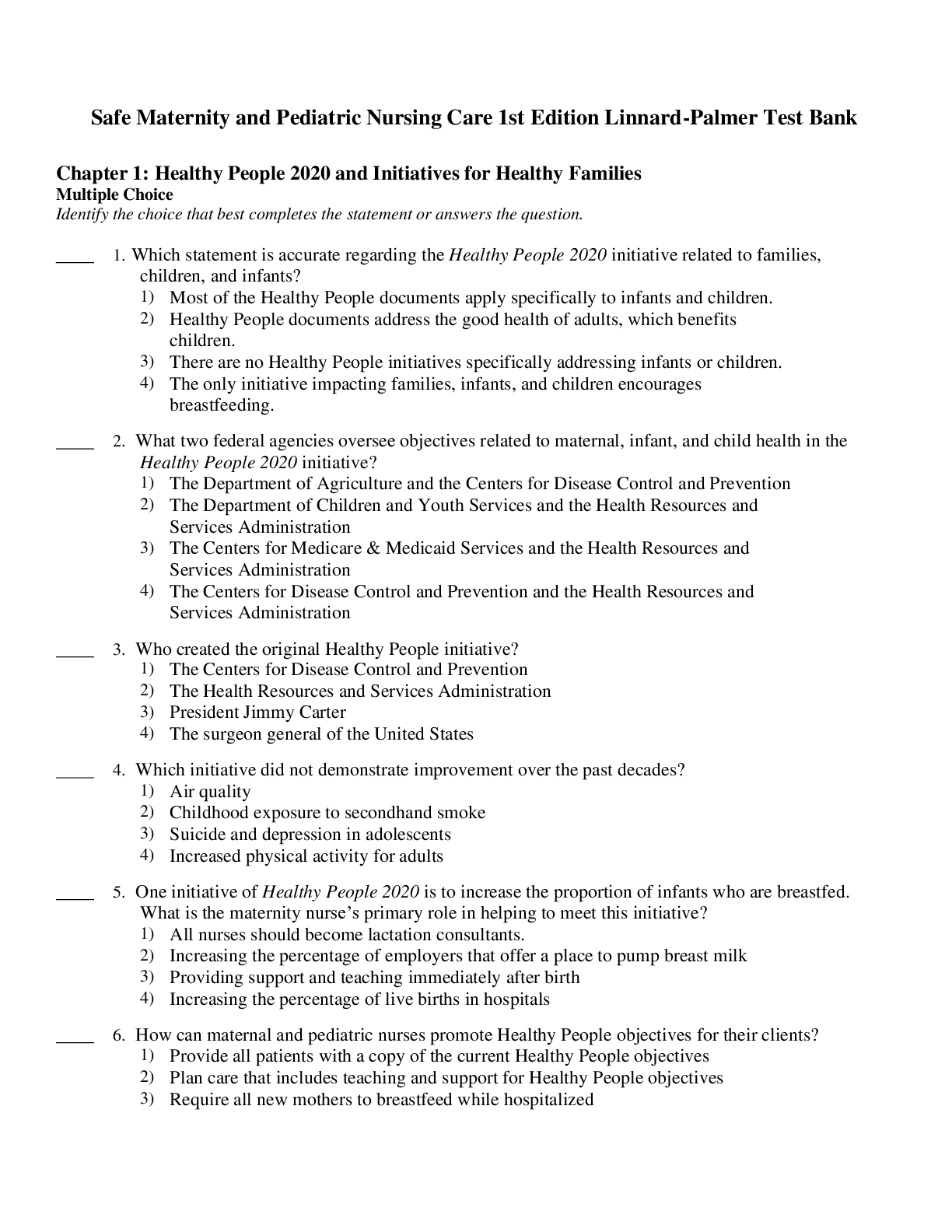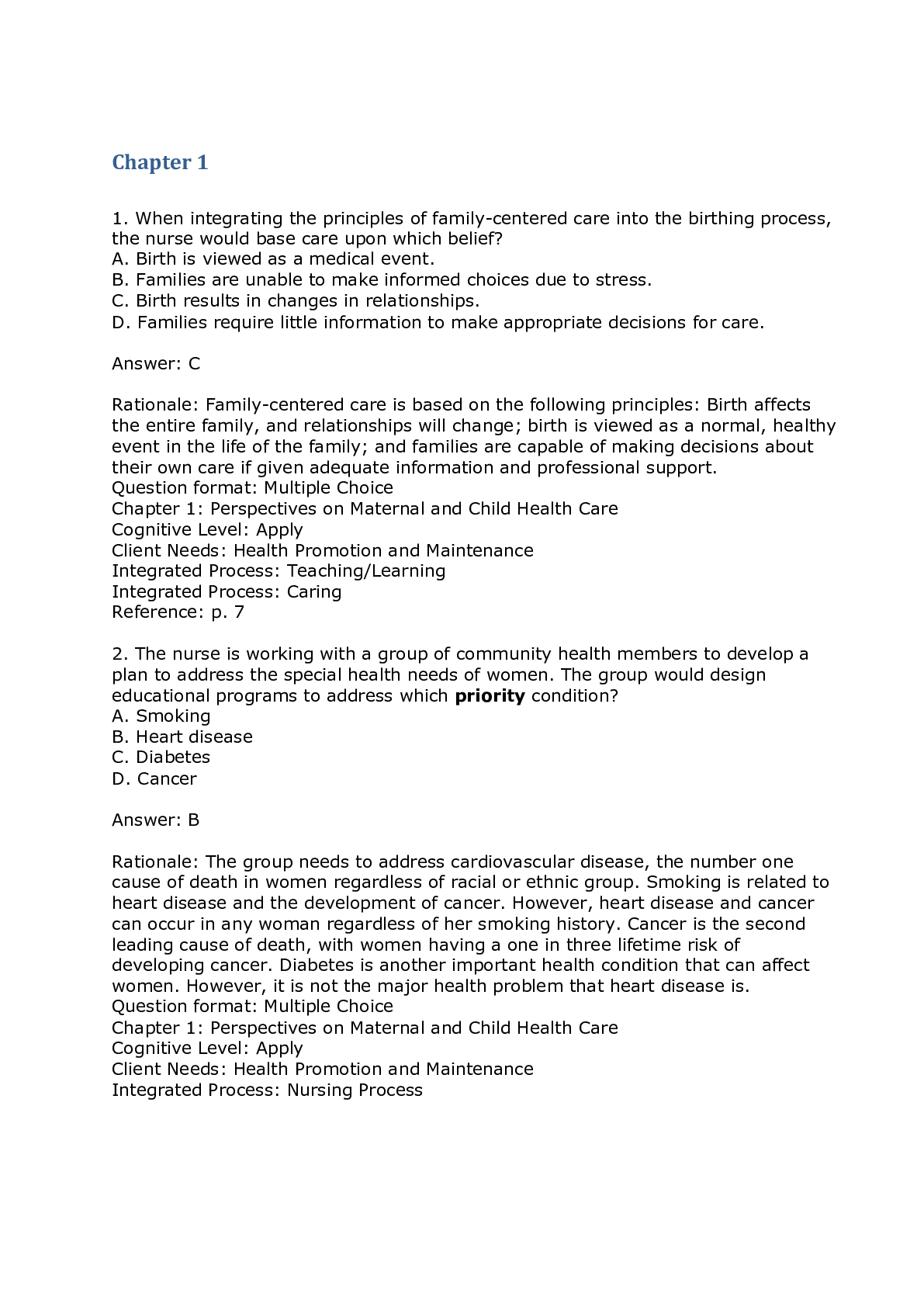*NURSING > TEST BANK > Test Bank - Introduction to Maternity and Pediatric Nursing 8e (by Leifer)The Child with a Condition (All)
Test Bank - Introduction to Maternity and Pediatric Nursing 8e (by Leifer)The Child with a Condition of the Blood, Blood-Forming Organs, or Lymphatic System,100% CORRECT
Document Content and Description Below
Test Bank - Introduction to Maternity and Pediatric Nursing 8e (by Leifer)The Child with a Condition of the Blood, Blood-Forming Organs, or Lymphatic System MULTIPLE CHOICE 1. The nurse is teachin... g the parents of a young child with iron deficiency anemia about nutrition. What food would the nurse emphasize as being a rich source of iron? a. An egg white b. Cream of Wheat c. A banana d. A carrot ANS: B Good nutritional sources of iron include boiled egg yolk, liver, green leafy vegetables, Cream of Wheat, dried fruits, beans, nuts, and whole-grain breads. DIF: Cognitive Level: Comprehension REF: Page 640 TOP: Iron Deficiency Anemia KEY: Nursing Process Step: Implementation MSC: NCLEX: Health Promotion and Maintenance: Prevention and Early Detection of Disease 2. Which statement by a mother may indicate a cause for her 9-month-olds iron deficiency anemia? a. Formula is so expensive. We switched to regular milk right away. b. She almost never drinks water. c. She doesnt really like peaches or pears, so we stick to bananas for fruit. d. I give her a piece of bread now and then. She likes to chew on it. ANS: A Because cows milk contains very little iron, infants should drink iron-fortified formula for the first year of life. NURSINGTB.COMDIF: Cognitive Level: Application REF: Pag TOP: Iron Deficiency Anemia KEY: Nursing Process Step: Evaluation MSC: NCLEX: Health Promotion and Maintenance: Prevention and Early Detection of Disease 3. What will the nurse administer with ferrous sulfate drops when providing them to a child on the pediatric unit? a. With milk b. With orange juice c. With water d. On a full stomach ANS: B Vitamin C aids in the absorption of iron, whereas food and milk interfere with the absorption of iron. DIF: Cognitive Level: Application REF: Page 640 TOP: Iron Deficiency Anemia KEY: Nursing Process Step: Implementation MSC: NCLEX: Physiological Integrity: Pharmacological Therapies 4. What is the result of a deficiency of factor IX? a. Thalassemia b. Idiopathic thrombocytopenic purpura c. Hemophilia A d. Christmas disease ANS: D Christmas disease, or hemophilia B, is caused by the deficiency of factor IX. DIF: Cognitive Level: Knowledge REF: Page 646 TOP: Christmas Disease KEY: Nursing Process Step: Implementation MSC: NCLEX: Physiological Integrity: Physiological Adaptation 5. A 2-year-old child has been diagnosed with hemophilia A. What information should the nurse include in a teaching plan about home care? a. If bleeding occurs, apply pressure, ice, elevate, and rest the extremity. b. Childrens aspirin in lowered doses may be given for joint discomfort. c. A firm, dry toothbrush should be used to clean teeth at least twice a day. d. Do not permit interactive play with other children. ANS: A When bleeding occurs, the traditional approach is to follow RICErest, ice, compression, and elevation. DIF: Cognitive Level: Application REF: Page 646 TOP: Hemophilia KEY: Nursing Process Step: Planning MSC: NCLEX: Physiological Integrity: Basic Care and Comfort 6. What will the nurse teach the parents of a child with a low platelet count to avoid? a. Ibuprofen b. Aspirin c. Caffeine d. Prednisone ANS: B Aspirin interferes with platelet function and should be avoided to prevent the risk of prolonged bleeding. DIF: Cognitive Level: Application REF: Page 647 TOP: Leukemia KEY: Nursing Process Step: Implementation MSC: NCLEX: Physiological Integrity: Pharmacological Therapies 7. What should the nurse closely assess in a chNilUdRrSecINeiGvTinBg.CaOtrMansfusion? a. Fever b. Lethargy c. Jaundice d. Bradycardia ANS: A The child receiving a blood transfusion is observed for signs of a transfusion reaction including chills, itching, fever, rash, headache, and back pain. DIF: Cognitive Level: Comprehension REF: Page 650 OBJ: 16 TOP: Blood Transfusion KEY: Nursing Process Step: Data Collection MSC: NCLEX: Physiological Integrity: Reduction of Risk 8. On admission, a child with leukemia has widespread purpura and a platelet count of 19,000/mm3. What is the priority nursing intervention? a. Assessing neurological status b. Inserting an intravenous line c. Monitoring vital signs during platelet transfusions d. Providing family education about how to prevent bleeding ANS: A When platelets are low, the greatest danger is spontaneous intracranial bleeding. Neurological assessments are therefore a priority of care. DIF: Cognitive Level: Application REF: Page 647 TOP: Leukemia KEY: Nursing Process Step: Planning MSC: NCLEX: Health Promotion and Maintenance: Prevention and Early Detection of Disease 9. An adolescent is diagnosed with Hodgkins disease. Lymph nodes on both sides of her diaphragm have been found to be involved, including cervical and inguinal nodes. Which disease stage is this? a. I b. II c. III d. IV ANS: C Lymph node regions on both sides of the diaphragm are consistent with a diagnosis of stage III Hodgkins disease. DIF: Cognitive Level: Application REF: Page 651 OBJ: N/A TOP: Hodgkins Disease KEY: Nursing Process Step: Data Collection MSC: NCLEX: Health Promotion and Maintenance: Prevention and Early Detection of Disease 10. A 3-year-old child with sickle cell disease is admitted to the hospital in sickle cell crisis with severe abdominal pain. Which type of crisis is the child most likely experiencing? a. Aplastic b. Hyperhemolytic c. Vaso-occlusive d. Splenic sequestration ANS: C Vaso-occlusive crisis, or painful crisis, is caused by obstruction of blood flow by sickle cells, infarctions, and some degrees of vasospasm. DIF: Cognitive Level: Application REF: Page 642 OBJ: 8 TOP: Sickle Cell Disease KEY: Nursing Process Step: Data Collection NURSINGTB.COM MSC: NCLEX: Physiological Integrity: Physiological Adaptation 11. Which statement made by a parent indicates an understanding of health maintenance of a child with sickle cell disease? a. I should give my child a daily iron supplement. b. It is important for my child to drink plenty of fluids. c. He needs to wear protective equipment if he plays contact sports. d. He shouldnt receive any immunizations until he is older. ANS: B Prevention of dehydration, which can trigger the sickling process, is a priority goal in the care of a child with sickle cell disease. DIF: Cognitive Level: Application REF: Page 644 TOP: Sickle Cell Disease KEY: Nursing Process Step: Evaluation MSC: NCLEX: Physiological Integrity: Basic Care and Comfort 12. A newly married couple is seeking genetic counseling because they are both carriers of the sickle cell trait. How can the nurse best explain the childrens risk of inheriting this disease? a. Every fourth child will have the disease; two others will be carriers. b. All of their children will be carriers, just as they are. c. Each child has a one in four chance of having the disease and a two in four chance of being a carrier. d. The risk levels of their children cannot be determined by this information. ANS: C The sickle cell gene is inherited from both parents; therefore each offspring has a one in four chance of inheriting the disease. DIF: Cognitive Level: Analysis REF: Page 643 OBJ: 7 TOP: Sickle Cell Disease KEY: Nursing Process Step: Implementation MSC: NCLEX: Physiological Integrity: Reduction of Risk 13. A child with thalassemia major receives blood transfusions frequently. What is a complication of repeated blood transfusions? a. Hemarthrosis b. Hematuria c. Hemoptysis d. Hemosiderosis ANS: D As a result of repeated blood transfusions, excessive deposits of iron (hemosiderosis) are stored in tissues. DIF: Cognitive Level: Comprehension REF: Page 645 TOP: Thalassemia KEY: Nursing Process Step: Data Collection MSC: NCLEX: Physiological Integrity: Physiological Adaptation 14. A child has just been diagnosed with acute lymphoblastic leukemia. What is the result of an overproduction of immature white blood cells in the bone marrow? a. Decreased T-cell production b. Decreased hemoglobin c. Increased blood clotting d. Increased susceptibility to infection ANS: D An overproduction of immature white blood cells increases the childs susceptibility to infection. DIF: Cognitive Level: Comprehension REF: Page 648 TOP: Leukemia KEY: Nursing Process Step: NDUatRaSCINolGleTcBti.oCnOM MSC: NCLEX: Physiological Integrity: Physiological Adaptation 15. The child receiving a transfusion complains of back pain and itching. What is the best initial action by the nurse? a. Notify the charge nurse. b. Disconnect intravenous lines immediately. c. Give diphenhydramine (Benadryl). d. Clamp off blood and keep line open with normal saline. ANS: D If a blood transfusion reaction occurs, the first action is to stop the blood infusion, keep the line open with normal saline, and notify the charge nurse. DIF: Cognitive Level: Application REF: Page 650 TOP: Blood Transfusion KEY: Nursing Process Step: Implementation MSC: NCLEX: Physiological Integrity 16. What would the nurse include in a teaching plan about mouth care of a child receiving chemotherapy? a. Use commercial mouthwash. b. Clean teeth with a soft toothbrush. c. Avoid use of a Water-Pik. d. Inspect the mouth weekly for ulcerations. ANS: B A soft toothbrush reduces capillary damage and mucous membrane breakdown and prevents bleeding and infection. Commercial mouthwashes may kill oral flora that combat infection. Water-Pik is useful for toughening gums. DIF: Cognitive Level: Application REF: Page 650 TOP: Leukemia KEY: Nursing Process Step: Planning MSC: NCLEX: Physiological Integrity: Basic Care and Comfort 17. A 6-year-old with leukemia asks, Who will take care of me in heaven? What is the best response by the nurse? a. Who do you think will take care of you? b. Your grandparents and God will take care of you. c. Your mom will know more about that than I do. d. Why are you asking me that? ANS: A This response gives the child an opportunity to verbalize his or her feelings and concerns, whereas closed responses shut off communication. The asking of a why question is not therapeutic as it calls for justification. DIF: Cognitive Level: Application REF: Page 650 TOP: Leukemia KEY: Nursing Process Step: Implementation MSC: NCLEX: Psychosocial Integrity: Coping and Adaptation 18. The nurse is dealing with a preschool-age child with a life-threatening illness. What should the nurse remember the childs concept of death is at this age? a. That it is final b. Only a fear of separation from her parents c. That a person becomes alive again soon after death d. An understanding based on simple logic ANS: C The preschooler views death as reversible and temporary. DIF: Cognitive Level: Comprehension REF: Page 656 OBJ: 19 TOP: Nursing Care of the Dying ChiNldURSINGTB.COM KEY: Nursing Process Step: Data Collection MSC: NCLEX: Psychosocial Integrity: Coping and Adaptation 19. The nurse notes that a 4-year-old childs gums bleed easily and he has bruising and petechiae on his extremities. Which lab value is consistent with these symptoms? a. Platelet count of 25,000/mm3 b. Hemoglobin level of 8 g/dL c. Hematocrit level of 36% d. Leukocyte count of 14,000/mm3 ANS: A The normal platelet count is 150,000 to 400,000/mm3. This finding is very low, indicating an increased bleeding potential. DIF: Cognitive Level: Analysis REF: Page 647 TOP: Idiopathic Thrombocytopenic Purpura KEY: Nursing Process Step: Data Collection MSC: NCLEX: Physiological Integrity: Physiological Adaptation 20. The nurse, caring for a child receiving chemotherapy, notes that the childs abdomen is firm and slightly distended. There is no record of a bowel movement for the last 2 days. What do these assessment findings suggest? a. Peripheral neuropathy b. Stomatitis c. Myelosuppression d. Hemorrhage ANS: A Peripheral neuropathy may be signaled by severe constipation resulting from decreased nerve sensations in the bowel. DIF: Cognitive Level: Analysis REF: Page 650 TOP: Leukemia KEY: Nursing Process Step: Data Collection MSC: NCLEX: Health Promotion and Maintenance: Prevention and Early Detection of Disease 21. The nurse finds an adolescent with Hodgkins disease crying. The adolescent says, I am so scared. What is the most appropriate nursing response to this comment? a. I understand how you must feel. b. You shouldnt feel that way. c. Is this the strongest feeling youve had today? d. Tell me whats got you scared. ANS: D The nurse should encourage the adolescent to express her feelings and concerns. DIF: Cognitive Level: Application REF: Page 656 TOP: Adolescent with CancerFear of Death KEY: Nursing Process Step: Implementation MSC: NCLEX: Psychosocial Integrity: Coping and Adaptation 22. The most recent blood count for a child who received chemotherapy last week shows neutropenia. What is the priority nursing diagnosis for this child? a. Risk for infection b. Risk for hemorrhage c. Altered skin integrity d. Disturbance in body image ANS: A The child with neutropenia is at risk for infectNioUnR. SINGTB.COM DIF: Cognitive Level: Application REF: Page 649 OBJ: 15 TOP: Chemotherapy: Neutropenia KEY: Nursing Process Step: Nursing Diagnosis MSC: NCLEX: Health Promotion and Maintenance: Prevention and Early Detection of Disease 23. What important focus of nursing care for the dying child and the family should the nurse implement? a. Nursing care should be organized to minimize contact with the child. b. Adequate oral intake is crucial to the dying child. c. Families should be made aware that hearing is the last sense to stop functioning before death. d. It is best for the family if the nursing staff provides all of the childs care. ANS: C Hearing is intact even when there is a loss of consciousness. DIF: Cognitive Level: Analysis REF: Page 656 TOP: Dying Child KEY: Nursing Process Step: Planning MSC: NCLEX: Physiological Integrity: Basic Care and Comfort 24. The nurse is presenting information on the congentital disorder of hemophilia A. What fact will the nurse include? a. It is seen in males and females equally. b. It is transmitted by symptom-free females. c. It is a sex-linked dominant trait. d. It is a defective gene located on the Y chromosome. ANS: B Hemophilia A affects mostly males who received the sex-linked recessive trait from a symptom-free female. The defective gene is on the X chromosome. DIF: Cognitive Level: Comprehension REF: Page 646 TOP: Hemophilia A KEY: Nursing Process Step: Planning MSC: NCLEX: Physiological Integrity: Physiological Adaptation 25. A child is diagnosed with iron deficiency anemia. What will the nurse explain can occur if this disorder goes untreated? a. Hemorrhage b. Heart failure c. Infection d. Pulmonary embolism ANS: B Untreated iron deficiency anemias progress slowly, and in severe cases the heart muscle becomes too weak to function. If this happens, heart failure follows. DIF: Cognitive Level: Comprehension REF: Page 640 TOP: Iron Deficiency Anemia KEY: Nursing Process Step: Data Collection MSC: NCLEX: Physiological Integrity: Physiological Adaptation MULTIPLE RESPONSE 26. The nurse is caring for a child with a low platelet count. What skin assessments would alert the nurse to bleeding? (Select all that apply.) a. Petichiae b. Purpura c. Ecchymosis d. Hematoma e. Lymphadenopathy ANS: A, B, C, D NURSINGTB.COM The reduction or destruction of platelets in the body interferes with the clotting mechanism. Skin lesions that are common to these disorders include petechiae, a bluish, nonblanching, pinpoint-sized lesion; purpura, groups of adjoining petechiae; ecchymosis, an isolated bluish lesion larger than a petechia; and hematoma, a raised ecchymosis. Lymphadenopathy is an enlargement of lymph nodes that is indicative of infection or disease. DIF: Cognitive Level: Comprehension REF: Page 647 TOP: Manifestations of Bleeding KEY: Nursing Process Step: Data Collection MSC: NCLEX: Physiological Integrity: Physiological Adaptation 27. Why would the nurse urge the family of a dying 12-year-old boy to include his 8-year-old sister in care? (Select all that apply.) a. She will feel less neglected by the parents. b. She can make amends for past hostilities to her brother. c. She will feel increased helplessness. d. She can express her feelings through care. e. She can experience being supportive of her parents and brother. ANS: A, B, D, E All options are potential benefits to including the sibling in the care of a dying child except increased helplessness. She would feel less helpless. DIF: Cognitive Level: Comprehension REF: Page 655 OBJ: 21 | 25 TOP: Siblings KEY: Nursing Process Step: Implementation MSC: NCLEX: Psychosocial Integrity: Coping and Adaptation 28. What should be included in the nursing care of a 12-year-old child receiving radiation therapy for Hodgkins disease? (Select all that apply.) a. Application of sunblock b. Appetite stimulation c. Conservation of energy d. Provision for expressions of anger e. Preparation for premature sexual development ANS: A, B, C, D Sun block should be applied to skin after radiation to prevent burning. Low energy levels produce anorexia and anger in many young patients. Radiation delays the development of secondary sex characteristics and menses. DIF: Cognitive Level: Application REF: Page 651 TOP: Effects of Radiation KEY: Nursing Process Step: Planning MSC: NCLEX: Physiological Integrity: Physiological Adaptation 29. What are the classic symptoms of thalassemia major (Cooleys anemia)? (Select all that apply.) a. Hepatomegaly b. Jaundice c. Protruding teeth d. Pathological fractures e. Renal failure ANS: A, B, C, D All of the options are classic signs of thalassemia major except renal failure. DIF: Cognitive Level: Comprehension REF: Page 645 TOP: Thalassemia Major KEY: Nursing Process Step: Data Collection MSC: NCLEX: Health Promotion and Maintenance: Prevention and Early Detection of Disease 30. How has synthetic recombinant antihemophilic factor improved the management of hemophilia? (Select all that apply.) a. Eliminates the need for frequent transfusionNsURSINGTB.COM b. Can be administered by family at home c. Prevents hemorrhage d. Reduces cost of care of the hemophiliac e. Reduces risk of HIV and hepatitis A and B transmission ANS: A, B, D, E The drug can be given at home by the family. Because it supplies the missing factor, transfusions are not necessary and consequently the exposure to HIV and hepatitis A and B is reduced. Cost of care is greatly reduced because hospitalizations and transfusions are not as frequently required. The drug does not prevent hemorrhage; it makes hemorrhage manageable. DIF: Cognitive Level: Comprehension REF: Page 646 TOP: Hemophilia A KEY: Nursing Process Step: Implementation MSC: NCLEX: Physiological Integrity: Pharmacological Therapies 31. The family of a child receiving chemotherapy for leukemia should be taught to focus on which aspect(s) of the childs care? (Select all that apply.) a. Using a support group b. Stimulating appetite c. Maintaining adequate hydration d. Continuing with scheduled immunizations e. Reporting exposure to infectious diseases ANS: A, B, C, E Support groups are helpful for emotional support and realistic tips on care. The child on chemotherapy is anorexic and has no appetite. Maintenance of hydration is essential for the adequate therapeutic effect of the drugs. Because the drugs suppress the bone marrow, children are at risk for infection, and the suppression will not allow the antibody response needed for immunization. DIF: Cognitive Level: Analysis REF: Page 650 OBJ: 15 | 21 TOP: Chemotherapy KEY: Nursing Process Step: Implementation MSC: NCLEX: Safe, Effective Care Environment: Coordinated Care 32. The nurse explains that the COPP medical regimen for the treatment of Hodgkins disease uses a combination of which drugs? (Select all that apply.) a. Vincristine b. Cyclophosphamide c. Methotrexate d. Prednisone e. Procarbazine hydrochloride ANS: A, B, D, E The COPP medical regimen includes the combination of cyclophosphamide, vincristine (Oncovin), prednisone and procarbazine hydrochloride. DIF: Cognitive Level: Knowledge REF: Page 651 TOP: COPP KEY: Nursing Process Step: Implementation MSC: NCLEX: Physiological Integrity: Pharmacological Therapies 33. A school-aged child is living with a chronic disease process. How would the nurse anticipate chronic illness will effect growth and development? (Select all that apply.) a. Delayed bonding with parents b. Delayed toilet training c. Impaired sense of belonging d. Decreased feelings of independence e. Impaired speech development ANS: C, D NURSINGTB.COM A school-age child is in the stage of industry versus inferiority. A chronic illness might experience loss of grade level in school because of illness and inability to participate or compete can lead to sense of inferiority. Sense of independence and accomplishment can be lost. Being different from peers may impede childs sense of belonging. DIF: Cognitive Level: Comprehension REF: Page 654 TOP: Chronic Illness/Growth and Development KEY: Nursing Process Step: Data Collection MSC: NCLEX: Psychosocial Integrity: Grief and Loss COMPLETION 34. The nurse shows slides of red blood cells from a child with sickle cell disease, noting that in addition to their sickle shape, the cells contain the abnormal element of . ANS: hemoglobin S Hemoglobin S is the abnormal hemoglobin that makes red blood cells fragile and causes the walls of the cells to collapse, giving them the characteristic sickle shape. DIF: Cognitive Level: Knowledge REF: Page 642 TOP: Sickle Cell Disease KEY: Nursing Process Step: Implementation MSC: NCLEX: Physiological Integrity: Physiological Adaptation 35. The nurse confirms that sickle cell trait can be distinguished from sickle cell disease by a lab test called . ANS: electrophoresis The hemoglobin electrophoresis is a blood test to check for different types of hemoglobin in the blood. Hemoglobin is the substance in red blood cells that carries oxygen. Electrophoresis uses an electrical current to separate normal and abnormal types of hemoglobin in the blood. Hemoglobin types have different electrical charges and move at different speeds. The amount of each hemoglobin type in the current is measured. An abnormal amount of normal hemoglobin or an abnormal type of hemoglobin in the blood may mean that a disease is present. A person with sickle cell disease has abnormal hemoglobin S cells. DIF: Cognitive Level: Knowledge REF: Page 642 TOP: Electrophoresis KEY: Nursing Process Step: Implementation MSC: NCLEX: Health Promotion and Maintenance: Prevention and Early Detection of Disease 36. To prevent , the nurse warms the blood that is to be given as a transfusion through a central line. ANS: cardiac arrhythmias Cold blood entering the heart via a central line can trigger an irregular heartbeat. DIF: Cognitive Level: Comprehension REF: Page 650 OBJ: 16 TOP: Blood Transfusion KEY: Nursing Process Step: Implementation MSC: NCLEX: Health Promotion and Maintenance: Prevention and Early Detection of Disease 37. The rate of RBC production is regulated by . ANS: erythropoietin NURSINGTB.COM Erythropoietin is a glycoprotein hormone that controls erythropoiesis or red blood cell production. DIF: Cognitive Level: Knowledge REF: Page 638 TOP: Components of Blood KEY: Nursing Process Step: Data Collection MSC: NCLEX: Physiological Integrity: Reduction of Risk Potential 38. Place the stages of dying in the usual order as detailed by Kbler-Ross (1975). Put a comma and space between each answer choice (a, b, c, d, etc.) a. Bargaining b. Acceptance c. Denial d. Anger e. Reaching out to help others f. Depression ANS: C, D, A, F, B, E The stages of dying as detailed by Kbler-Ross (1975)denial, anger, bargaining, depression, acceptance, and reaching out to help otherscan be applied to parents and siblings as well as to the sick child. (Nurses may also respond with similar feelings.) It is important to accept and support each participant at whatever stage has been reached and to refrain from directing progress. DIF: Cognitive Level: Comprehension REF: Page 656 TOP: Stages of Dying KEY: Nursing Process Step: Data Collection MSC: NCLEX: Psychosocial Integrity: End of Life Concepts [Show More]
Last updated: 10 months ago
Preview 1 out of 20 pages
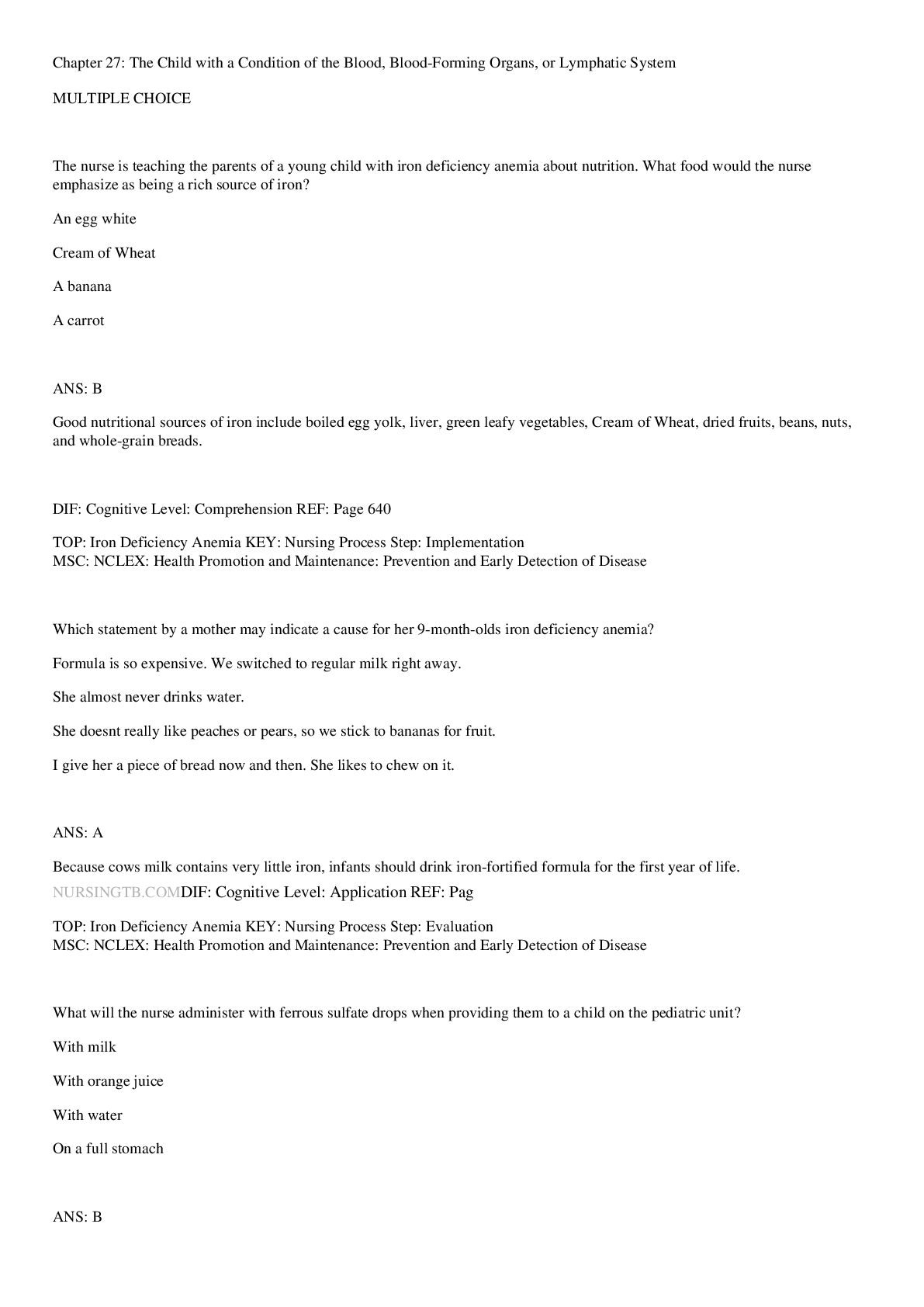
Reviews( 0 )
Document information
Connected school, study & course
About the document
Uploaded On
Jul 19, 2022
Number of pages
20
Written in
Additional information
This document has been written for:
Uploaded
Jul 19, 2022
Downloads
0
Views
29

